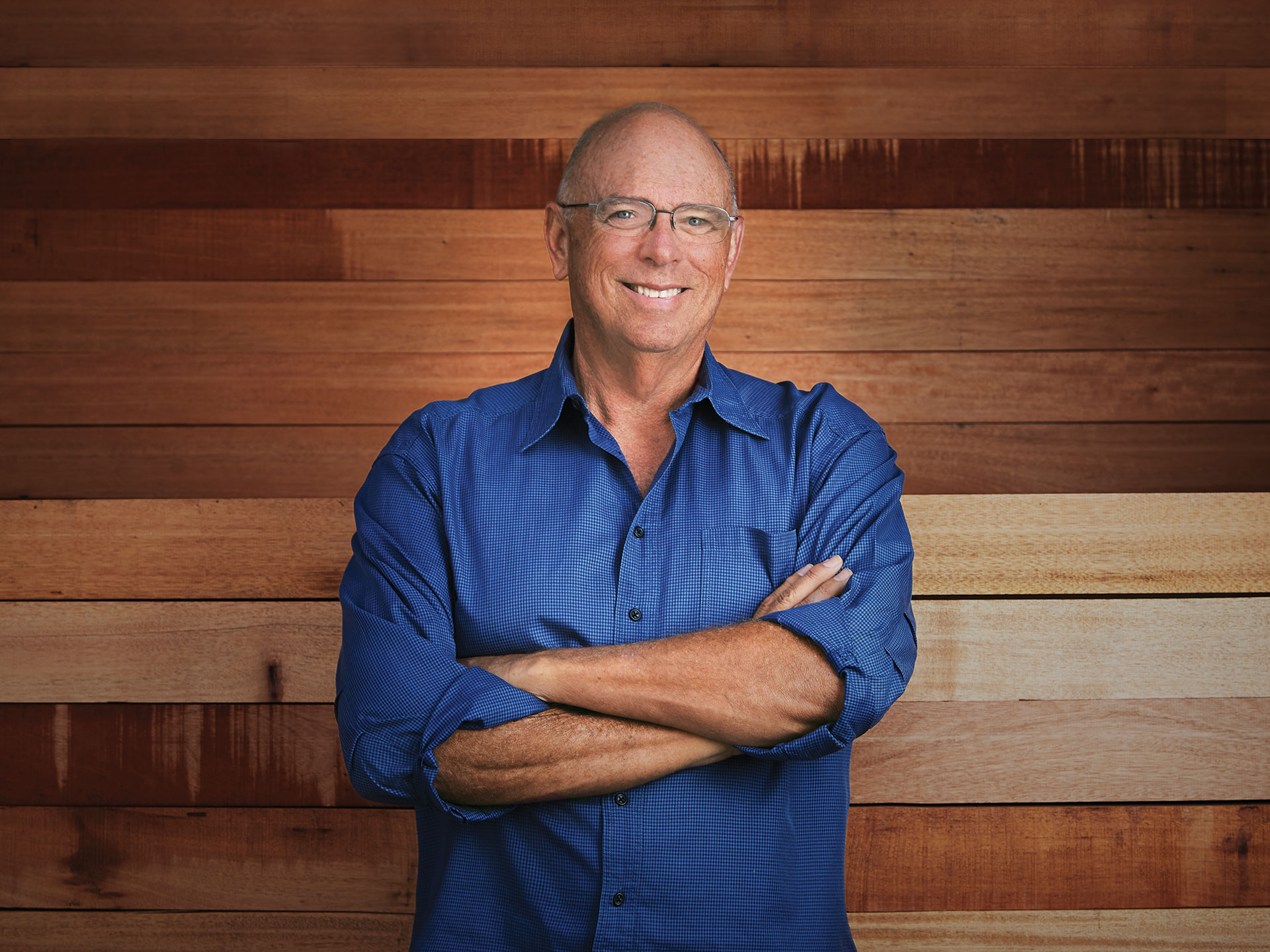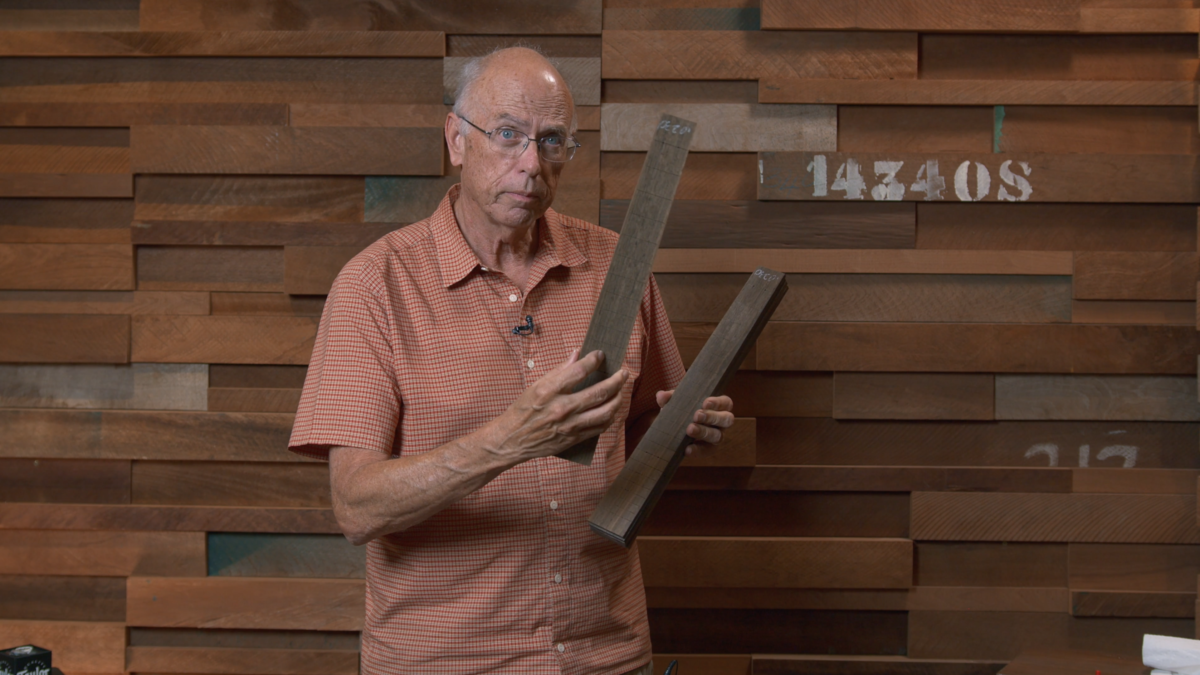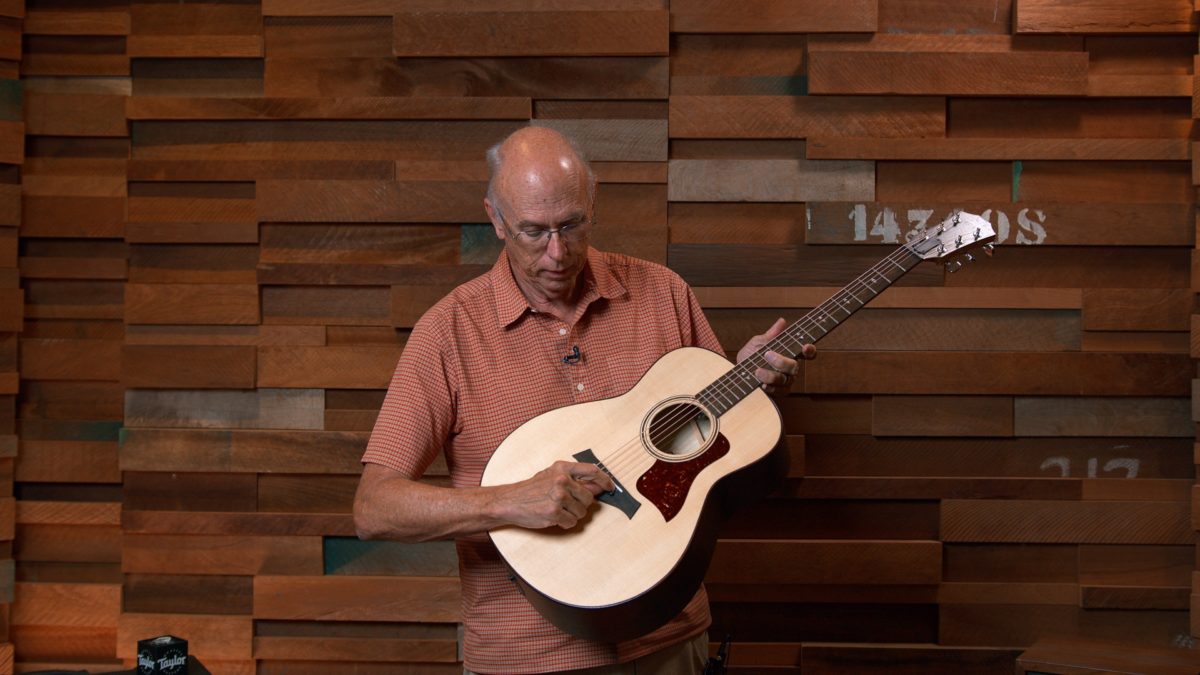With this edition of Ask Bob, you’ll find an extra helping of questions, plus some additional content we hope you’ll enjoy. For starters, now that we’ve also launched a digital edition of Wood&Steel, Bob answers a couple of questions via video, which allows him to illustrate some of the topics he discusses. (If you missed Bob’s video on bearclaw spruce from our last edition, be sure to check it out.)
Also, in July, Bob joined our weekly Taylor Primetime livestream show (episode 10), hosted on Taylor’s YouTube channel, for a rapid-fire Ask Bob Q&A based on submissions from Taylor fans. As always, Bob shares his insights in an engaging and forthcoming way. Now onto the latest batch of questions for Bob…
I’m quite excited about the new American Dream guitars. I’ve never heard of using eucalyptus for a fretboard! How and why did you decide to go that route, and what “regular” fretboard would it be considered similar to in hardness and feel? Read Answer
Yes, Geoffrey, we’re on to something new here. There are many species of eucalyptus, each with different properties. The one we’re using for fingerboards is fairly easy to darken its color through and through. I’d say it’s quite close to an Indian rosewood fingerboard in color, hardness and tone. This same wood can be used for sides and backs as well, and is in plentiful supply as it’s been planted all over the world for a hundred years. I should take a moment to repeat my opinion that there’s not much reason for me to get excited about using synthetics to make guitars. I’ve always said that there are so many good timbers to use if we run shy on the most popular species, or if we just want to not increase their use or even slow the use down. This is just one new example. And we all know about our Urban Ash. I’ll take these materials over carbon graphite or high-pressure paper-based laminates any day. A little more work, but guitars made from wood are nicer, easily done, and easily sustained into the future. I think you’ll like these fingerboards.
I once heard that a certain guitar maker turned CEO went on the factory floor and made a guitar. When the quality checks were done, they trashed it because it didn’t meet their standards. Could you go onto the floor, make a (Bob Taylor) guitar, and have it pass the quality checks these days? Read Answer
Tom, yes, I can. There isn’t anything in the factory that I can’t do unless my aging eyesight gets in the way of a detail. But I don’t mind saying that I know how to make guitars, or machines, or fixtures. Becoming the president of this company didn’t take away those skills.
Ed. Note: Tom, that’s a great question, so we thought it would be cool to open it up to a few other longtime Taylor employees who’ve learned from Bob and might have their own perspectives to share. Hopefully it paints a more vivid picture not only of Bob’s guitar-making skills, but of the high standards of craftsmanship he established throughout the company.
Ed Granero (24 years), VP of Product Development
When you build a company from the ground up, you end up knowing every detail. I worked in production making guitars for many years, and it never ceased to amaze me when Bob would walk by and point out a detail I was working on that wasn’t quite right. He would always leave me thinking, “How does Bob, who has so much going on and doesn’t work day-to-day in my department, ‘see’ everything that is wrong?” It wasn’t until years later when I finally realized that I was able to do the same thing that Bob would do to me. It was because Bob knows and cares about every detail of not only the guitar itself, but of the process, the tools, the space, the layout…everything.
For those of us fortunate to have worked with Bob over the years, we understand and share the commitment to paying attention to the details. It’s that attention to detail that leads us to sustained success.
Terry Myers (31 years), R&D/Special Projects
I have a thousand stories. What we all learn quickly is Bob fully understands and obsesses over every aspect of what he does, and he has done nearly every aspect of what Taylor Guitars is. Not only can he build an amazing guitar, he can conceptualize and build the machinery behind it. His depth of awareness will catch you off-guard every time.
Rob Magargal (29 years), Service Network Manager
In 1991-92 I was learning how to fret to our standards. I was struggling with why my work looked great when I left, yet when I came back the next day, the fingerboards had changed, and I had slight lifts at the end of the fingerboards. I said, “Bob, I need help.” He looked at one guitar and said, “Rob, you’re thinking electric guitars. They are straight down to the last fret. These are acoustics, and the relief must stop at or around the body joint. That way you can add a slight drop-off over the body. The extension only follows the body.” Talk about being hit with a brick! From that point on, my sand-outs and fret jobs were as good as anything we could ever do. Four months later, I’m training everyone how to fret. That continued all the way until our patented Taylor neck — which Bob designed — came along.
Side note: I personally dreaded when Bob would come into the Final Assembly room and look at guitars. Here’s why. One day he walks by my four guitars in the bin behind me. Without missing a step, as he walks by he says, “Rob, the washer on the tuner for the B string, second guitar back, is upside-down.” I turned around and…it was upside-down. If he saw that just walking by, what does he see when he’s holding the guitar?!
David Judd (28 years), Product Development
There are dozens of times when Bob would come by and try to impart some wisdom on me. The worst was when you would proudly show him your work and he would push his glasses up and look close. One day when I was managing the Body department, I got in early, and Bob was waiting for me with a trash can. He made it quite clear that we were wasting too much sandpaper, and proceeded to pull out handfuls of half-used sandpaper to make his point. We got the point.
Chris Wellons (28 years), VP of Manufacturing
I recall a time Bob was walking through the factory, stopped dead in his tracks, turned on a dime, and walked directly to the table saw where someone was working. He had heard the sound of the blade cutting wood and knew the blade was dull. Or he would walk by a cart of guitar necks or bodies and randomly pick up the one that had an issue or blemish…it’s instinctive and always has been. I’ve spent time with Bob on weekends as well on personal projects and have learned hundreds of things from him along the way – he is very well-versed not just in guitar building but in everything he gets into, from machinery to off-roading, woodworking, cabinetmaking, you name it!
With the retirement announcement from Chris Martin IV and with fellow luthiers Jean Larrivée, Richard Hoover, Ren Ferguson and yourself, not to forget Bill Collings (RIP), looking to pass the baton to the new crop of master luthiers, what do you think your generation’s legacy will be? Read Answer
Good question, David. All these people you mentioned are great friends of mine. People have often asked me what I’d like said about me in relation to guitars when I pass on, and my answer for years has been, “He left guitars in better shape than he found them.” I think everyone you mentioned has done exactly that. That’s an honorable legacy, in my opinion. Truly, guitars today are so much more advanced, and good, than they were in the early ’70s when we all came on the scene. When I think about the options to buy a guitar back then, it was nothing like it is now, and all these luthiers from our generation made it this way.
Why do some think the fretboard wood type makes a tonal difference, when the string vibration is from metal to plastic or bone? You don’t seem to hear a difference when the fretting finger moves over the fret markers. Read Answer
Well, it does make a difference, Alan. Electric guitar players are sure that rosewood fingerboards sound different than maple fingerboards. Actually, everything makes a difference because it’s all vibrating and interacting. That’s actually what’s going on. The whole guitar is set into motion, and it all adds up to the sound. But can you perceive it? If I sit on an elephant, will he weigh more on the scale? Yes. But probably nobody, including the elephant, can feel it. Some changes are small in comparison to the whole, and may make a difference in one kind of guitar more than in another. If I sit on a horse, it’s more easily perceived because me and the horse are closer in size than me and the elephant. Frankly, on steel-string acoustics, I personally don’t hear a difference from one fingerboard to another. But maybe across hundreds, I might hear the flavor of one compared to another. What about a classical guitar? Maybe the difference is more pronounced there. People do tend to focus on tiny changes, hoping to inch their way to the “best” result. I believe in that, because those all add up to a whole. But take one of them out and replace it with something that’s 90 percent the same and it’s hard to perceive when blended into how the things work together as a whole. Replace it with something awful and you can hear it. Replace it with something twice as good, you can hear it. I wouldn’t choose pine for a fingerboard, as that’s going too far. But if they’re all in the ballpark, you still have a good guitar.
Why did Taylor switch to Micarta saddles over Tusq? Read Answer
Dean, it’s because of the structure of the material. Tusq is a great product. It’s injected into a mold, so it can have micro spots inside where its density changes. We began to hear that when we made the ES2 pickup because different saddles sounded different from sensor to sensor, or even saddle to saddle. The Micarta we use is made up of layers of paper, pressed with resin into a sheet. We cut our saddles from this so the sheets run bottom to top of the saddle, and the layers run front to back. This gives uniform vibration transfer and sounds better in our opinion. It’s more balanced from string to string and guitar to guitar, so pickup balancing becomes easy. The funny thing is, once we heard it in the amplified state, we began to perceive it in the acoustic state as well. We still use Tusq at this time for nuts because of tooling issues. There will come a day when we’re able to make nuts from Micarta. By the way, Micarta is a brand name, in the same way that Formica is a brand name. The material we use, and what most Micarta is, is paper-based phenolic sheet. It’s important to find the right one. We had to look far and wide to get the one that worked. It’s all in the manufacturing of the product itself, and we’re happy to have found this one.
In addition to my other Taylor guitars, I proudly own a 712ce 12-Fret WSB, which I purchased nearly three years ago. I love them all. However, I have a problem with the case that came with my 712. It does not hold the humidity in the case. I use D’Addario Humidipaks, which need replacing every month. No matter the time of the year or the location of my guitars around the house, the packs in the 712 dry out quickly. The other guitars are OK. The case I got has six latches. I saw some cases in the store that have only 4. Please explain. By the way, this 712 has brought romance back to my guitar playing. These 80-year-old hands feel young again! Read Answer
Pastor Carroll, I think it might be a good idea to get your case itself humidified. I’m assuming it’s a bona fide Taylor case with our brown color and brass logo. We haven’t made a case with six latches for some time if I’m correct. Sometimes I’m not! If it’s not a Taylor case, I’d get one for sure. You must live in a dry area if the packs are drying up once a month. Here are some tips that I can think of. Keep your case closed even when you play your guitar. If it sits open while you play, it can dry out, and then you’re trying to humidify it with the Humidipaks, and it can use up a lot more water than the guitar. Our case isn’t meant to be moisture-sealed, but it does do a pretty good job. When we make cases, we actually make sure the humidity inside the case is just right before we put a guitar in it; otherwise it can suck the moisture from the guitar. We also put the case and guitar in a plastic bag when we box them. In your case (no pun intended), you might want to put a larger water source like a Dampit inside the case and open it once a day for a few days. If the Dampit is dry after a day, then the case needed that water. Re-wet it. Repeat until the Dampit stays supple. Then put in a double bag of Humidipaks and see how it goes.
You recently redesigned the Grand Symphony in the 800 and Koa Series. Are there any plans to extend that redesign to other lines? I’d really love to have a 500 Series Grand Symphony, and I’m worried I’ve missed my chance other than ordering a custom guitar. Read Answer
Tim, custom guitars are fun! Feel free to order. But, as you’ll see in this issue, we’re introducing the 326ce now, so that’s some movement across the line. I’m not sure if or when we’ll introduce a 500 Series option, so you’ll want to keep your eyes peeled. Or ask your dealer to do that for you, even if it comes as a limited edition one day.
Have your neck profiles changed in the last couple of decades? I’ve got a 2000 312ce and find the new necks don’t feel the same…. I think the shape of the older neck is pretty splendid. Read Answer
Yes, Matt, they have changed slightly over the last couple decades. One change is the neck profile curve doesn’t bite into the fingerboard as much. This was an improvement to ensure longevity of the neck binding, which results in better re-fretting possibilities. It was also a result of being able to hold our design better. Earlier in our history, there was much more hand work that deviated from our intended shape, removing wood where we didn’t want to. People might have been too aggressive with a sander! Over time, as we listened to the average comments, the neck became the tiniest bit bigger. Not much, mind you, but you can feel it. We do have slimmer shapes available as custom options. The neck on your guitar from 2000 is probably a bit smaller than we make now on our normal guitar, but you can always get a slim-carve neck if you want to order one.
Bonus Video
We often receive questions about the different degrees of coloration found in ebony, so Bob gathered an array of ebony fretboard blanks to show some examples of its color range.
Got a question for Bob Taylor?
Shoot him an email: askbob@taylorguitars.com
If you have a specific repair or service concern, please call our Customer Service department at (800) 943-6782, and we’ll take care of you.



